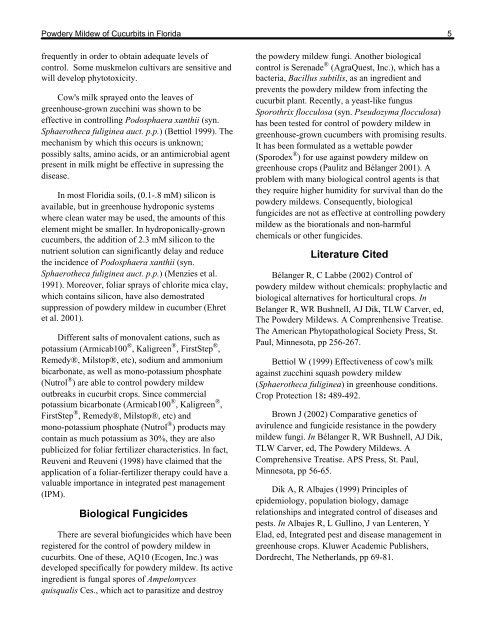Powdery Mildew of Cucurbits in Florida - Orange County Extension ...
Powdery Mildew of Cucurbits in Florida - Orange County Extension ...
Powdery Mildew of Cucurbits in Florida - Orange County Extension ...
You also want an ePaper? Increase the reach of your titles
YUMPU automatically turns print PDFs into web optimized ePapers that Google loves.
<strong>Powdery</strong> <strong>Mildew</strong> <strong>of</strong> <strong>Cucurbits</strong> <strong>in</strong> <strong>Florida</strong> 5<br />
frequently <strong>in</strong> order to obta<strong>in</strong> adequate levels <strong>of</strong><br />
control. Some muskmelon cultivars are sensitive and<br />
will develop phytotoxicity.<br />
Cow's milk sprayed onto the leaves <strong>of</strong><br />
greenhouse-grown zucch<strong>in</strong>i was shown to be<br />
effective <strong>in</strong> controll<strong>in</strong>g Podosphaera xanthii (syn.<br />
Sphaerotheca fulig<strong>in</strong>ea auct. p.p.) (Bettiol 1999). The<br />
mechanism by which this occurs is unknown;<br />
possibly salts, am<strong>in</strong>o acids, or an antimicrobial agent<br />
present <strong>in</strong> milk might be effective <strong>in</strong> supress<strong>in</strong>g the<br />
disease.<br />
In most Floridia soils, (0.1-.8 mM) silicon is<br />
available, but <strong>in</strong> greenhouse hydroponic systems<br />
where clean water may be used, the amounts <strong>of</strong> this<br />
element might be smaller. In hydroponically-grown<br />
cucumbers, the addition <strong>of</strong> 2.3 mM silicon to the<br />
nutrient solution can significantly delay and reduce<br />
the <strong>in</strong>cidence <strong>of</strong> Podosphaera xanthii (syn.<br />
Sphaerotheca fulig<strong>in</strong>ea auct. p.p.) (Menzies et al.<br />
1991). Moreover, foliar sprays <strong>of</strong> chlorite mica clay,<br />
which conta<strong>in</strong>s silicon, have also demostrated<br />
suppression <strong>of</strong> powdery mildew <strong>in</strong> cucumber (Ehret<br />
et al. 2001).<br />
Different salts <strong>of</strong> monovalent cations, such as<br />
potassium (Armicab100 ® , Kaligreen ® , FirstStep ® ,<br />
Remedy®, Milstop®, etc), sodium and ammonium<br />
bicarbonate, as well as mono-potassium phosphate<br />
(Nutrol ® ) are able to control powdery mildew<br />
outbreaks <strong>in</strong> cucurbit crops. S<strong>in</strong>ce commercial<br />
potassium bicarbonate (Armicab100 ® , Kaligreen ® ,<br />
FirstStep ® , Remedy®, Milstop®, etc) and<br />
mono-potassium phosphate (Nutrol ® ) products may<br />
conta<strong>in</strong> as much potassium as 30%, they are also<br />
publicized for foliar fertilizer characteristics. In fact,<br />
Reuveni and Reuveni (1998) have claimed that the<br />
application <strong>of</strong> a foliar-fertilizer therapy could have a<br />
valuable importance <strong>in</strong> <strong>in</strong>tegrated pest management<br />
(IPM).<br />
Biological Fungicides<br />
There are several bi<strong>of</strong>ungicides which have been<br />
registered for the control <strong>of</strong> powdery mildew <strong>in</strong><br />
cucurbits. One <strong>of</strong> these, AQ10 (Ecogen, Inc.) was<br />
developed specifically for powdery mildew. Its active<br />
<strong>in</strong>gredient is fungal spores <strong>of</strong> Ampelomyces<br />
quisqualis Ces., which act to parasitize and destroy<br />
the powdery mildew fungi. Another biological<br />
control is Serenade ® (AgraQuest, Inc.), which has a<br />
bacteria, Bacillus subtilis, as an <strong>in</strong>gredient and<br />
prevents the powdery mildew from <strong>in</strong>fect<strong>in</strong>g the<br />
cucurbit plant. Recently, a yeast-like fungus<br />
Sporothrix flocculosa (syn. Pseudozyma flocculosa)<br />
has been tested for control <strong>of</strong> powdery mildew <strong>in</strong><br />
greenhouse-grown cucumbers with promis<strong>in</strong>g results.<br />
It has been formulated as a wettable powder<br />
(Sporodex ® ) for use aga<strong>in</strong>st powdery mildew on<br />
greenhouse crops (Paulitz and Bélanger 2001). A<br />
problem with many biological control agents is that<br />
they require higher humidity for survival than do the<br />
powdery mildews. Consequently, biological<br />
fungicides are not as effective at controll<strong>in</strong>g powdery<br />
mildew as the biorationals and non-harmful<br />
chemicals or other fungicides.<br />
Literature Cited<br />
Bélanger R, C Labbe (2002) Control <strong>of</strong><br />
powdery mildew without chemicals: prophylactic and<br />
biological alternatives for horticultural crops. In<br />
Belanger R, WR Bushnell, AJ Dik, TLW Carver, ed,<br />
The <strong>Powdery</strong> <strong>Mildew</strong>s. A Comprenhensive Treatise.<br />
The American Phytopathological Society Press, St.<br />
Paul, M<strong>in</strong>nesota, pp 256-267.<br />
Bettiol W (1999) Effectiveness <strong>of</strong> cow's milk<br />
aga<strong>in</strong>st zucch<strong>in</strong>i squash powdery mildew<br />
(Sphaerotheca fulig<strong>in</strong>ea) <strong>in</strong> greenhouse conditions.<br />
Crop Protection 18: 489-492.<br />
Brown J (2002) Comparative genetics <strong>of</strong><br />
avirulence and fungicide resistance <strong>in</strong> the powdery<br />
mildew fungi. In Bélanger R, WR Bushnell, AJ Dik,<br />
TLW Carver, ed, The <strong>Powdery</strong> <strong>Mildew</strong>s. A<br />
Comprehensive Treatise. APS Press, St. Paul,<br />
M<strong>in</strong>nesota, pp 56-65.<br />
Dik A, R Albajes (1999) Pr<strong>in</strong>ciples <strong>of</strong><br />
epidemiology, population biology, damage<br />
relationships and <strong>in</strong>tegrated control <strong>of</strong> diseases and<br />
pests. In Albajes R, L Gull<strong>in</strong>o, J van Lenteren, Y<br />
Elad, ed, Integrated pest and disease management <strong>in</strong><br />
greenhouse crops. Kluwer Academic Publishers,<br />
Dordrecht, The Netherlands, pp 69-81.
















